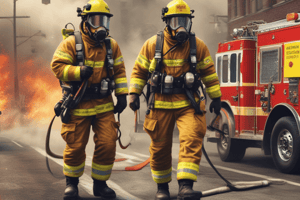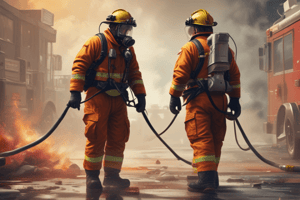Podcast
Questions and Answers
Firefighters have a 300% increased risk for __________ disease.
Firefighters have a 300% increased risk for __________ disease.
cardiac
Maintaining high levels of physical __________ is crucial for firefighter safety.
Maintaining high levels of physical __________ is crucial for firefighter safety.
fitness
Exposure to smoke and __________ can affect firefighters' health.
Exposure to smoke and __________ can affect firefighters' health.
chemicals
A lack of __________ can lead to multiple health issues for firefighters.
A lack of __________ can lead to multiple health issues for firefighters.
Wearing dirty and contaminated __________ is a risk for cancer among firefighters.
Wearing dirty and contaminated __________ is a risk for cancer among firefighters.
A fire protection ______ checks plans for proposed buildings to ensure compliance with local fire codes.
A fire protection ______ checks plans for proposed buildings to ensure compliance with local fire codes.
An emergency medical ______ provides basic life support for victims of accidents.
An emergency medical ______ provides basic life support for victims of accidents.
A ______ provides advanced life support for the victims of accidents or illnesses.
A ______ provides advanced life support for the victims of accidents or illnesses.
The ______ officer administers all fire department training activities.
The ______ officer administers all fire department training activities.
General Operating ______ establish a standard course of action for fire departments.
General Operating ______ establish a standard course of action for fire departments.
The ______ Officer monitors incident operations and advises the Incident Commander.
The ______ Officer monitors incident operations and advises the Incident Commander.
The Incident Command ______ includes the Incident Commander and the Command Staff.
The Incident Command ______ includes the Incident Commander and the Command Staff.
A ______ Officer provides a point of contact for other agencies during an incident.
A ______ Officer provides a point of contact for other agencies during an incident.
Firefighters must have a VO2 max of at least ______ ml/kg/min.
Firefighters must have a VO2 max of at least ______ ml/kg/min.
Muscular endurance is the ability of a muscle or group of muscles to perform repetitive activities without ______.
Muscular endurance is the ability of a muscle or group of muscles to perform repetitive activities without ______.
Flexibility refers to the range of motion around a ______.
Flexibility refers to the range of motion around a ______.
Nutrition is essential for firefighters as improper fuel can lead to inadequate ______.
Nutrition is essential for firefighters as improper fuel can lead to inadequate ______.
Fruits and vegetables provide ______ that help protect our bodies against the effects of chronic stress.
Fruits and vegetables provide ______ that help protect our bodies against the effects of chronic stress.
Typical American diets are often high in fat, sugar, refined grains, sodium, and other ______.
Typical American diets are often high in fat, sugar, refined grains, sodium, and other ______.
Carbohydrates are the primary source of ______ for the brain.
Carbohydrates are the primary source of ______ for the brain.
Sugars are a quick source of energy but can also lead to cravings and cause wide swings in ______-sugar levels.
Sugars are a quick source of energy but can also lead to cravings and cause wide swings in ______-sugar levels.
Firefighters must ensure that all PPE is on the apparatus in its proper location and in ______ condition.
Firefighters must ensure that all PPE is on the apparatus in its proper location and in ______ condition.
When the emergency alarm sounds, firefighters must stay ______ and listen to dispatch information.
When the emergency alarm sounds, firefighters must stay ______ and listen to dispatch information.
The incident commander must consider the most severe factors and ______ management to determine overall incident strategy.
The incident commander must consider the most severe factors and ______ management to determine overall incident strategy.
The tactical priority in a structure fire that comes first is ______ safety.
The tactical priority in a structure fire that comes first is ______ safety.
An important benchmark is the Personnel Accountability Report (PAR) which ensures companies in the hazard zone are safe and ______ for.
An important benchmark is the Personnel Accountability Report (PAR) which ensures companies in the hazard zone are safe and ______ for.
In highway incidents, firefighters should turn the front wheels of blocking apparatus away from the emergency so it will not be ______ into the emergency responders.
In highway incidents, firefighters should turn the front wheels of blocking apparatus away from the emergency so it will not be ______ into the emergency responders.
Firefighters should wear ______ vests when PPE is not required at highway incidents.
Firefighters should wear ______ vests when PPE is not required at highway incidents.
Firefighters must quickly and calmly mount apparatus wearing proper gear and ______ themselves into the riding position.
Firefighters must quickly and calmly mount apparatus wearing proper gear and ______ themselves into the riding position.
Control zones will keep bystanders a safe distance from the ______.
Control zones will keep bystanders a safe distance from the ______.
Zones are commonly labeled 'hot,' 'warm,' and ______.
Zones are commonly labeled 'hot,' 'warm,' and ______.
Cordoning can be done with rope or fireline or caution ______.
Cordoning can be done with rope or fireline or caution ______.
Every fire department must use some system of ______ that identifies and tracks all personnel.
Every fire department must use some system of ______ that identifies and tracks all personnel.
The passport system can aid in accounting for personnel within the ______ zone.
The passport system can aid in accounting for personnel within the ______ zone.
Upon leaving the hazard zone, the officers collect their ______.
Upon leaving the hazard zone, the officers collect their ______.
Each company officer will report to command either 'PAR' if their company is ______.
Each company officer will report to command either 'PAR' if their company is ______.
There is no specific distance from the scene or area that should be ______.
There is no specific distance from the scene or area that should be ______.
Activities that present a significant risk to the safety of members shall be limited to situations where there is a potential to save ______ lives.
Activities that present a significant risk to the safety of members shall be limited to situations where there is a potential to save ______ lives.
No risk to the safety of members shall be acceptable when there is no possibility to save lives or ______.
No risk to the safety of members shall be acceptable when there is no possibility to save lives or ______.
Team integrity is vital to safety and must always be emphasized, as no ______ is worth the life of a firefighter.
Team integrity is vital to safety and must always be emphasized, as no ______ is worth the life of a firefighter.
Highest fireground priority is for firefighters to protect their lives and those of their fellow ______.
Highest fireground priority is for firefighters to protect their lives and those of their fellow ______.
Firefighters must have all of their ______ on when they enter the cab of the apparatus.
Firefighters must have all of their ______ on when they enter the cab of the apparatus.
To lift properly, firefighters should keep their back as straight as possible and lift with their ______.
To lift properly, firefighters should keep their back as straight as possible and lift with their ______.
Slips, trips, and falls often result from poor footing caused by slippery surfaces, uneven surfaces, and lack of ______ when climbing stairs.
Slips, trips, and falls often result from poor footing caused by slippery surfaces, uneven surfaces, and lack of ______ when climbing stairs.
Removing seatbelts in order to don PPE is strictly ______.
Removing seatbelts in order to don PPE is strictly ______.
Flashcards
Fire Protection Engineer/Specialist
Fire Protection Engineer/Specialist
Ensures buildings comply with fire and life safety codes by reviewing plans and consulting with fire departments on operations and prevention.
Emergency Medical Technician (EMT)
Emergency Medical Technician (EMT)
Provides basic life support (BLS) to victims of accidents or illnesses.
Paramedic
Paramedic
Provides advanced life support (ALS) to victims of accidents or illnesses.
Training Officer
Training Officer
Signup and view all the flashcards
General Operating Guidelines (GOGs)
General Operating Guidelines (GOGs)
Signup and view all the flashcards
Safety Officer (ICS)
Safety Officer (ICS)
Signup and view all the flashcards
Liaison Officer (ICS)
Liaison Officer (ICS)
Signup and view all the flashcards
Incident Commander (IC)
Incident Commander (IC)
Signup and view all the flashcards
Firefighter Injury Prevention
Firefighter Injury Prevention
Signup and view all the flashcards
Cardiovascular Disease Risk
Cardiovascular Disease Risk
Signup and view all the flashcards
Cancer Risk Factors
Cancer Risk Factors
Signup and view all the flashcards
Turnout Gear Contamination
Turnout Gear Contamination
Signup and view all the flashcards
Cardiovascular Endurance
Cardiovascular Endurance
Signup and view all the flashcards
VO2 max
VO2 max
Signup and view all the flashcards
Muscular Strength
Muscular Strength
Signup and view all the flashcards
Muscular Endurance
Muscular Endurance
Signup and view all the flashcards
Flexibility
Flexibility
Signup and view all the flashcards
Body Composition
Body Composition
Signup and view all the flashcards
Carbohydrates
Carbohydrates
Signup and view all the flashcards
Protein
Protein
Signup and view all the flashcards
Simple Carbs
Simple Carbs
Signup and view all the flashcards
Risk to Firefighters
Risk to Firefighters
Signup and view all the flashcards
Property Protection Risks
Property Protection Risks
Signup and view all the flashcards
Unacceptable Risk
Unacceptable Risk
Signup and view all the flashcards
Team Integrity
Team Integrity
Signup and view all the flashcards
Abandoned Buildings
Abandoned Buildings
Signup and view all the flashcards
Highest Fireground Priority
Highest Fireground Priority
Signup and view all the flashcards
PPE on Apparatus
PPE on Apparatus
Signup and view all the flashcards
Safe Apparatus Mounting
Safe Apparatus Mounting
Signup and view all the flashcards
What are the tactical priorities in a structure fire?
What are the tactical priorities in a structure fire?
Signup and view all the flashcards
What is an Incident Action Plan (IAP)?
What is an Incident Action Plan (IAP)?
Signup and view all the flashcards
Personnel Accountability Report (PAR)
Personnel Accountability Report (PAR)
Signup and view all the flashcards
What does "All Clear" signify in an incident?
What does "All Clear" signify in an incident?
Signup and view all the flashcards
When is an incident considered "Under Control"?
When is an incident considered "Under Control"?
Signup and view all the flashcards
What does "Loss Stopped" indicate in an incident?
What does "Loss Stopped" indicate in an incident?
Signup and view all the flashcards
What precautions should be taken at highway incidents for blocking apparatus?
What precautions should be taken at highway incidents for blocking apparatus?
Signup and view all the flashcards
How do responders cordon off an incident?
How do responders cordon off an incident?
Signup and view all the flashcards
Control Zones
Control Zones
Signup and view all the flashcards
Hot Zone
Hot Zone
Signup and view all the flashcards
Warm Zone
Warm Zone
Signup and view all the flashcards
Cold Zone
Cold Zone
Signup and view all the flashcards
Personnel Accountability System
Personnel Accountability System
Signup and view all the flashcards
Passport System
Passport System
Signup and view all the flashcards
Accountability Officer (AO)
Accountability Officer (AO)
Signup and view all the flashcards
Study Notes
Greensboro Fire Department Training Division - Orientation & Safety
-
Fire Service Culture:
- Volunteer Departments: Predominant type, often with per-call reimbursement.
- Paid-on-Call Departments: Reimbursed for each call, primarily for larger towns and cities.
- Career Departments: Primarily serve large towns and cities.
- Combination Departments: Combine full-time career and volunteer/paid-on-call firefighters.
-
Necessary Characteristics & Behaviors:
- Integrity: Doing the right thing.
- Work Ethic: Doing what needs to be done.
- Pride: Taking pride in oneself and work, beginning with personal presentation.
-
Primary Responsibilities:
- Daily company drills and scheduled training.
- Pre-incident planning, including knowledge of building and area hazards.
- Participating in departmental community service and educational programs.
- Cleaning stations, equipment, and apparatus.
- EMT certification maintenance.
- Daily physical training.
- Understanding and utilizing the firehouse reporting system.
-
Fire Service Mission:
- Saving lives and protecting property.
-
Tactical Priorities:
- Life Safety: Highest priority in emergencies.
- Incident Stabilization: Preventing escalation of incidents.
- Property Conservation: Saving property without putting firefighters at risk.
-
Unity of Command:
- Reporting to only one supervisor at a time.
-
Chain of Command:
- Hierarchical order of authority for communication flow.
-
Span of Control:
- Number of individuals/groups one person can effectively manage (3-7, optimally 5).
-
Division of Labor:
- Breaking down large tasks into smaller, manageable jobs.
-
Necessary In The Fire Service -Preventing duplication of effort
- Clear-cut assignments
-
Discipline:
- Organizational responsibility to guide and enforce rules.
- Individual accountability for following directives.
- Intended to correct inappropriate behavior and uphold rules.
-
Company Types:
- Engine Companies: Hose lines for fire attack and exposure protection.
- Truck Companies: Forcible entry, search & rescue, ventilation, salvage.
- Rescue Companies: Removing victims from hazardous areas.
- Hazardous Materials Companies: Responding to and mitigating hazardous materials incidents.
- USAR Companies: Performing technical rescues.
-
Primary Knowledge and Skills:
- Meeting NFPA 1001 standards for firefighter qualifications.
- Understanding department organization, operation, and guidelines.
- Meeting health and fitness standards.
- Meeting educational requirements of the local authority having jurisdiction (AHJ).
-
Fire Department Personnel Roles:
- Engineer: Fire apparatus operations.
- Fire Department Officer: Varies with department size, and may include supervising a fire company/group of fire companies.
-
Other Roles:
- Safety officer
- Personnel administration
- Public information
- Fire prevention
- Planning & resources
-
Special Operations Personnel:
- Airport firefighters
- Hazardous materials technicians
- Technical rescuers
- Foam Operations personnel
-
Fire & Life Safety Personnel:
- Fire prevention officers & inspectors, investigating fires and code compliance.
- Fire protection engineers/specialists
- Fire and life safety educators
-
Emergency Medical Services (EMS):
- Emergency medical technicians (EMTs) providing basic life support to accident or illness victims.
- Paramedics providing advanced life support (ALS).
-
Training Personnel:
- Training officers administering firefighter training programs.
-
General Operating Guidelines (GOGs):
- Established procedures for standard course of action.
- Reducing confusion and improving command and control.
-
Incident Management System (ICS):
- Used in incidents, involving the Incident Commander (IC) and Command Staff.
- Including Safety Officer, Liaison Officer, PIO, and other agencies
-
ICS Terms:
- Resources that are either assigned or available.
- Organizational levels between Divisions/Groups and the IC/Operations.
- Function of directing, ordering, and controlling resources.
- Locations where incident operations are directed.
- Designation for assigning responsibility for areas of operations.
-
Battalions and Companies: Organizational divisions and their equipment and staffing.
-
Incident Action Plan (IAP):
- Written plan for managing emergencies.
-
Firefighter Safety and Health:
- Causes of firefighter deaths (stress, vehicles, caught/trapped).
- Hometown Heroes Survivors Benefit Act.
- Firefighter injuries by type.
-
Behavioral Health:
- Chronic stress vs. acute stress impacting firefighters
-
Safety and Health: Key National Fire Protection Association (NFPA) requirements
-
Equipment and Tool Safety:
- Proper use of tools, PPE, preventing accidents including slips and falls in the workplace, and power tools
-
Emergency Operations:
- Preparedness during shifts
- Addressing emergency alarms, incidents, responding with safety considerations (proper gear, team contact).
-
Incident Management System (ICS): Incident accountability and communications during emergencies.
-
Fireground Priorities: Prioritizing firefighter safety above all else.
-
Highway Incidents: Traffic control and safety considerations in incidents on roadways.
-
Accountability Systems: Ensuring that everyone in an emergency is accounted for.
-
May Day Procedure: Protocol for immediate alerting
Studying That Suits You
Use AI to generate personalized quizzes and flashcards to suit your learning preferences.




